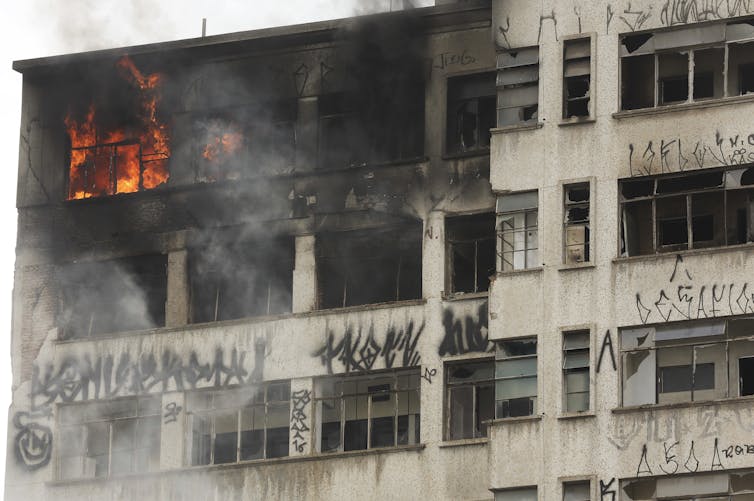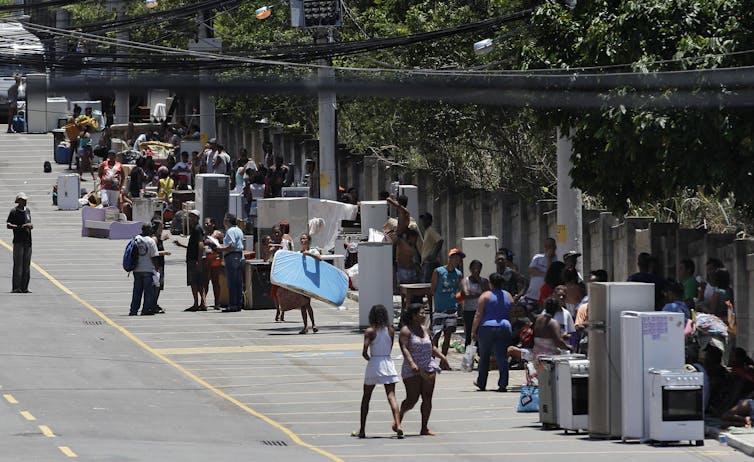Deadly highrise fire in Brazil spotlights city's housing crisis and the squatter movement it spawned
- Written by Patricia Rodrigues Samora, Professor of Architecture and Urban Planning, Pontifical Catholic University of Campinas
A massive fire in historic downtown São Paulo[1], Brazil, on May 1 has killed at least one person, with three more suspected dead[2]. Several neighboring buildings, including a church, were destroyed, scorched or evacuated.
The 25-story building that caught fire and later collapsed was a vacant former police headquarters now occupied by squatters. Most of the several hundred homeless people living there escaped[3], though they lost everything – including pets – to the blaze.
The tragedy[4] has shined a light on the homelessness crisis underway in this South American country of 200 million and exposed a social movement I study as an urban planning professor[5]: Brazil’s powerful homeless workers’ movement.
Concentrated land ownership
Brazil’s squatter movement reflects the country’s severe urban housing crisis[6]. Brazil’s housing deficit is estimated at 6 million units[7], according to the national census.
Urban homelessness has risen quickly in recent years. From 2013 to 2016, the homeless population[8] of Rio de Janeiro tripled, from 5,000 to 15,000.
In São Paulo, Brazil’s biggest city, an estimated 25,000 people live on the street. Many more live in informal settlements and slums. According to the city’s 2016 housing plan, São Paulo would need to build 368,731 new housing units[9] to house all households currently living in risky situations.
The roots of Brazil’s housing shortage go back to slavery. By the time Brazil formally abolished slavery in 1888[10], there were some 1.5 million freed people of African descent[11] – but none were given financial compensation, land or housing to help them start their lives anew.
Portuguese rule left Brazil with a royal land grant system[12] that enabled the wealthiest individuals claim massive amounts of land as their own in the post-colonial period, while millions of poor farmers and formerly enslaved people were left landless[13]. Today, 1 percent of Brazilians still own half of all the land in the country[14].
This inequality has given rise to numerous rural land reform efforts. The well-known Rural Landless Workers Movement has 2 million members nationwide[15] and has settled approximately 350,000 families on small plots[16] since its founding in 1994.
Its strategy: occupying unused land in the country’s sparsely populated interior and then working with policymakers to establish legal rights.
Housing crisis
The urban homeless movement grew out of this successful agrarian reform movement.
Squatters began organizing in São Paulo in the 1980s[17]. Today at least 14 major Brazilian cities have homeless organizations[18] that systematically occupy vacant buildings as a way to provide housing for members and advocate for more democratic, inclusive and affordable cities[19].
The biggest of these groups, the Roofless Workers Movement[20], recently gained international attention when several dozen members occupied a vacant beachfront apartment[21] allegedly gifted to former President Luiz Inácio Lula da Silva as a bribe.
The triplex was used as evidence in the controversial April 2018 corruption conviction that has now Lula serving a 12-year jail sentence[22]. However, no property deed was ever found and Lula denies that he owns the apartment.
After Lula was taken into police custody in early April[23], outraged supporters from the Roofless Workers Movement staged a high-profile squat in the beachfront apartment, unfurling a banner that read[24], “If it’s Lula’s, then it’s ours. And if it’s not his, why was he arrested?”
 A neighboring building in downtown São Paulo also caught fire on May 1, 2018, after the federal police station collapsed in flames.
AP Photo/Andre Penner
A neighboring building in downtown São Paulo also caught fire on May 1, 2018, after the federal police station collapsed in flames.
AP Photo/Andre Penner
In the 1980s and 1990s, Brazilian cities – like those in Latin America[25] and the United States[26] – saw inner-city populations decline. As residents fled for the suburbs, downtowns across the country were left littered with abandoned buildings.
In 2000, an estimated 38,000 apartments and office spaces in downtown São Paulo[27] sat empty. By the late 1990s, São Paulo’s homeless movements had identified these vacant structures as an opportunity.
Previously, housing advocates had been pushing the mayor’s office to build new apartment buildings in the sprawling city’s outskirts, where land is more affordable. But living far from downtown has some major disadvantages. One 2017 survey found that the average São Paulo resident’s commute was 2 hours and 53 minutes[28].
So, with the support of housing advocates and researchers, São Paulo’s homeless community began pressuring local government to buy up abandoned downtown buildings – conveniently located near transit and jobs – and transform them into affordable housing.
Then, citing a Brazilian constitutional right to housing[29], some shantytown residents took their advocacy to the next level. In 1997, they occupied an abandoned building.
São Paulo’s squatters
São Paulo Mayor Marta Suplicy felt enough pressure that in 2001 her administration launched “Live Downtown,” a program intended to resettle[30] homeless people and slum dwellers into affordable permanent housing.
The city planned to buy up or seize some 3,600 abandoned structures[31], make them livable and then rent them, subsidized, to poor families. Suplicy also created “social interest” zones[32] to stimulate affordable housing development in certain areas of the city, including downtown.
However, the “social housing” units that have emerged from this program have tended to be priced for working and middle-class families[33]. And Suplicy’s downtown repopulation program did not outlast her term, which ended in 2004.
Throughout these failed official efforts, the squatters have continued occupying empty buildings. Most of the time, the owners quickly obtain a judicial order to have police evict the squatters. They then take up residence in another abandoned building, starting the cycle over again.
 Evicted squatters in São Paulo vacate an abandoned building with all their belongings in 2014.
AP Photo/Leo Correa
Evicted squatters in São Paulo vacate an abandoned building with all their belongings in 2014.
AP Photo/Leo Correa
According to my interviews[34] with homeless activists, the squatters choose buildings that have laid empty for many years and whose owners owe significant back fines. That makes it more likely the city can seize the property.
They also targeted empty government buildings – especially those owned by the federal government – because they find that it makes negotiations easier.
Occasionally, squatters manage to stay put. The film “Leva” tells the history of the Mauá squat, one of São Paulo’s rare long-standing occupations[35].
Currently, an average of 70 buildings[36] in downtown São Paulo are occupied on any given day, though reliable data is scarce. The Roofless Workers Movement reports that 40,000 families in six states are currently on its waiting list[37].
A 2008 documentary[38] paints a lovely portrait of the homeless movement, focusing on four female squatters about to move into their new temporary home. It’s called “Dia de Festa” – “party day.” That’s what squatters call it every time they annex and occupy a new building.
References
- ^ massive fire in historic downtown São Paulo (www.washingtonpost.com)
- ^ three more suspected dead (www.theguardian.com)
- ^ escaped (www.chicagotribune.com)
- ^ tragedy (istoe.com.br)
- ^ urban planning professor (scholar.google.com.br)
- ^ severe urban housing crisis (nextcity.org)
- ^ is estimated at 6 million units (www.fjp.mg.gov.br)
- ^ homeless population (g1.globo.com)
- ^ 368,731 new housing units (gestaourbana.prefeitura.sp.gov.br)
- ^ formally abolished slavery in 1888 (books.google.com)
- ^ 1.5 million freed people of African descent (www.palmares.gov.br)
- ^ royal land grant system (climatepolicyinitiative.org)
- ^ poor farmers and formerly enslaved people were left landless (www.oxfam.org.br)
- ^ 1 percent of Brazilians still own half of all the land in the country (www.npr.org)
- ^ 2 million members nationwide (reporterbrasil.org.br)
- ^ 350,000 families on small plots (www.mst.org.br)
- ^ organizing in São Paulo in the 1980s (www.nytimes.com)
- ^ 14 major Brazilian cities have homeless organizations (epoca.globo.com)
- ^ advocate for more democratic, inclusive and affordable cities (www.favelasaopaulomedellin.fau.usp.br)
- ^ Roofless Workers Movement (www.mtst.org)
- ^ occupied a vacant beachfront apartment (www1.folha.uol.com.br)
- ^ evidence in the controversial April 2018 corruption conviction that has now Lula serving a 12-year jail sentence (theconversation.com)
- ^ taken into police custody in early April (theconversation.com)
- ^ unfurling a banner that read (24.sapo.pt)
- ^ like those in Latin America (www.redalyc.org)
- ^ United States (www.city-journal.org)
- ^ 38,000 apartments and office spaces in downtown São Paulo (www.moradiacentral.org.br)
- ^ 2017 survey found that the average São Paulo resident’s commute was 2 hours and 53 minutes (www.nossasaopaulo.org.br)
- ^ Brazilian constitutional right to housing (www.ssrn.com)
- ^ a program intended to resettle (www.moradiacentral.org.br)
- ^ 3,600 abandoned structures (www.prefeitura.sp.gov.br)
- ^ created “social interest” zones (www.academia.edu)
- ^ priced for working and middle-class families (nextcity.org)
- ^ my interviews (www.academia.edu)
- ^ one of São Paulo’s rare long-standing occupations (www.youtube.com)
- ^ an average of 70 buildings (www1.folha.uol.com.br)
- ^ 40,000 families in six states are currently on its waiting list (oglobo.globo.com)
- ^ 2008 documentary (youtu.be)
Authors: Patricia Rodrigues Samora, Professor of Architecture and Urban Planning, Pontifical Catholic University of Campinas

